 Who is the blogger?
Who is the blogger?
To see a simple English version of reviews about some of the movies, click on the ESL section of Midnight Oil.
Entries in 1940's films (11)
It's a Wonderful Life (1946)
“It’s a Wonderful Life” is the kind of film everyone loves to see (and see again) no matter what time of year it is. It seems like the more things change, the more a film like this stays the same. It provides a kind of film-watchers’ comfort food as we hurtle at breakneck speed through the ensuing decades of personal, societal, and cinematic evolution. Perhaps some of us are not so sure anymore of why exactly we like this movie, how the tradition of watching it got started or if the film is really all that good in the first place. We know that it’s a 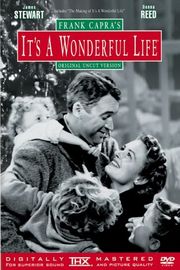 part of a well-worn tradition (like eating fruitcake and turkey giblet gravy at Christmas). For that reason, if for no other, we are bound to see it again some time.
part of a well-worn tradition (like eating fruitcake and turkey giblet gravy at Christmas). For that reason, if for no other, we are bound to see it again some time.
There’s just something terribly likeable about that everyman character, George Bailey (played by Jimmy Stewart). It’s not that he’s all that good looking or extremely clever or exceptionally charming or anything else. He’s just supposed to be an ordinary “nice guy”. In this big old mean old world, even nice guys can have some pretty big problems. At a certain point, George’s charmed life comes crashing in upon him and he finds  himself about to jump off a bridge to put an end to it all. George Bailey wonders out loud if his life has really been worth living. A guardian angel (played by Henry Travers) is immediately dispatched from the heavenly realms in order to put things to rights. With the help of the unearthly messenger, George comes to realize that his life has had a tremendous impact, not only on his immediate family members, but on the whole community.
himself about to jump off a bridge to put an end to it all. George Bailey wonders out loud if his life has really been worth living. A guardian angel (played by Henry Travers) is immediately dispatched from the heavenly realms in order to put things to rights. With the help of the unearthly messenger, George comes to realize that his life has had a tremendous impact, not only on his immediate family members, but on the whole community.
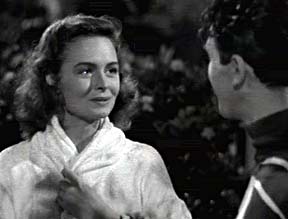 Wholesome is a good word to describe this film. It’s not a type of picture that you would see made today. Maudlin might be another word employed by some detractors of the film who would have little patience for such a cinematic work. But then, such people might not really appreciate how things work and what exactly goes on around the family dinner table each Christmas at our house. There are just certain dishes that Mother makes for every Christmas dinner (like the orange
Wholesome is a good word to describe this film. It’s not a type of picture that you would see made today. Maudlin might be another word employed by some detractors of the film who would have little patience for such a cinematic work. But then, such people might not really appreciate how things work and what exactly goes on around the family dinner table each Christmas at our house. There are just certain dishes that Mother makes for every Christmas dinner (like the orange 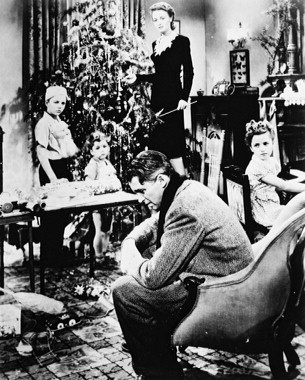 jellied salad or the buttered spicy squash). If you come as a guest for the dinner every year, you know that you are going to have to eat those dishes. It does no good to complain. You might as be reconciled with the traditional menu offering and find the virtues of the said salad. You’ll enjoy things a lot more if you do. And after all, what’s so bad about being good? Milk is wholesome too. It can be quite pleasant if you are used to it. And you would probably miss it if you could
jellied salad or the buttered spicy squash). If you come as a guest for the dinner every year, you know that you are going to have to eat those dishes. It does no good to complain. You might as be reconciled with the traditional menu offering and find the virtues of the said salad. You’ll enjoy things a lot more if you do. And after all, what’s so bad about being good? Milk is wholesome too. It can be quite pleasant if you are used to it. And you would probably miss it if you could 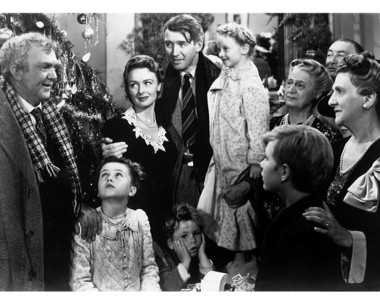 no longer have it. That’s kind of how I feel about “It’s a Wonderful Life”.
no longer have it. That’s kind of how I feel about “It’s a Wonderful Life”.
>>Not so Real Life: Sarah takes a chance on striking out in a new direction. Dealing with disappointments
>>More to see: Looking for more out of life?
See the three minute summary of "It's a Wonderful Life" (1946). Also see the scene where George lassos the moon.
The Snake Pit (1948)
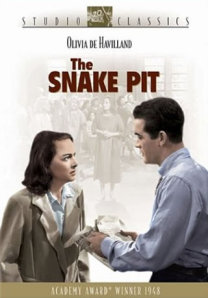 “The Snake Pit” has Olivia de Havilland play the part of Virginia Cunningham, a young woman who finds herself locked up in a mental asylum. The film is taken from a novel by Mary Jane Ward and is directed by Anotole Litvak. It combines the point of view of the disoriented and harassed patient, Virginia, with external elements that keep the film firmly grounded in reality. In spite of the efforts of her loving husband (Mark Stevens) and Dr. Mark Kik (Leo Genn) to reach her,
“The Snake Pit” has Olivia de Havilland play the part of Virginia Cunningham, a young woman who finds herself locked up in a mental asylum. The film is taken from a novel by Mary Jane Ward and is directed by Anotole Litvak. It combines the point of view of the disoriented and harassed patient, Virginia, with external elements that keep the film firmly grounded in reality. In spite of the efforts of her loving husband (Mark Stevens) and Dr. Mark Kik (Leo Genn) to reach her, 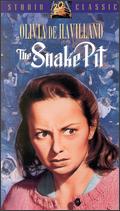 the harrowing experiences of the mental patient continue for a full two hours. “The Snake Pit” is an unusually honest film about mental illness for 1948, even if it does enter the realms of the melodramatic and over the top psycho-analysis at times.
the harrowing experiences of the mental patient continue for a full two hours. “The Snake Pit” is an unusually honest film about mental illness for 1948, even if it does enter the realms of the melodramatic and over the top psycho-analysis at times.>>Real Life: John struggled with the mental grief of a lifelong physical affliction. Why couldn't he just be normal?
>>More to see: Looking for more out of life?
Catch the TVO video trailer for "The Snake Pit" (1948
Video excerpt from "The Snake Pit" (1948)
The More the Merrier (1943)
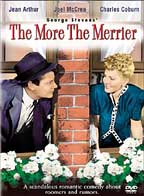 “The More the Merrier”(1943) IMDb starring Jean Arthur, Joel McCrea and Charles Coburn is indeed a merry little tale set in war-time Washington. A severe housing shortage in the city serves as the pretext for throwing together the unlikely trio. The well put together Miss Constance Milligan finds herself discombobulated by her two new housemates in more ways than one. Chaos ensues that ends with
“The More the Merrier”(1943) IMDb starring Jean Arthur, Joel McCrea and Charles Coburn is indeed a merry little tale set in war-time Washington. A severe housing shortage in the city serves as the pretext for throwing together the unlikely trio. The well put together Miss Constance Milligan finds herself discombobulated by her two new housemates in more ways than one. Chaos ensues that ends with 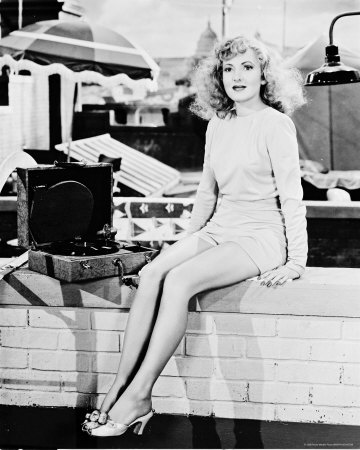 a complete reconfiguration of living arrangements and relationship status. As they say, “All’s well that ends well.” The mores of the times on display in this romantic comedy might be considered quaint these days. However, once you are ready to entertain the pretense of the whole scenario, there really are some funny bits to be enjoyed.
a complete reconfiguration of living arrangements and relationship status. As they say, “All’s well that ends well.” The mores of the times on display in this romantic comedy might be considered quaint these days. However, once you are ready to entertain the pretense of the whole scenario, there really are some funny bits to be enjoyed.
>>More to see: Looking for more out of life?
Catch a video excerpt of the "front steps" scene from "The More the Merrier" (1943)
The Lady From Shanghai (1947)
 “The Lady from Shanghai” (1947) stars Rita Hayworth as Elsa Bannister and Orson Welles as Micahel O’Hara. Welles does it all as principle actor, writer and director of the movie. It is an interesting film from more than one angle (à la crazy fun
“The Lady from Shanghai” (1947) stars Rita Hayworth as Elsa Bannister and Orson Welles as Micahel O’Hara. Welles does it all as principle actor, writer and director of the movie. It is an interesting film from more than one angle (à la crazy fun  house mirrors of the climax scene). Hayworth and Welles were in the final phases of their off-screen relationship at the time of filming, Welles reported that he did the film simply as a way of financing other projects in jeopardy, and the complicated plot of the original Sherwood King novel is just, well, hard to follow. But then, Michael O’Hara’s Irish brogue is rather hard to follow and even harder to swallow at times.
house mirrors of the climax scene). Hayworth and Welles were in the final phases of their off-screen relationship at the time of filming, Welles reported that he did the film simply as a way of financing other projects in jeopardy, and the complicated plot of the original Sherwood King novel is just, well, hard to follow. But then, Michael O’Hara’s Irish brogue is rather hard to follow and even harder to swallow at times.
 Rita Hayworth’s character is the rather too obvious femme fatale who spices up the exotic scenery and even indulges us with a musical number and a spectacular cliff diving scene for the benefit of box office sales. It’s film noir with more than the usual twist at the end with a visually discombobulating fun house scene that is all “Orson”. It can be fun, if you just relax and get into the
Rita Hayworth’s character is the rather too obvious femme fatale who spices up the exotic scenery and even indulges us with a musical number and a spectacular cliff diving scene for the benefit of box office sales. It’s film noir with more than the usual twist at the end with a visually discombobulating fun house scene that is all “Orson”. It can be fun, if you just relax and get into the 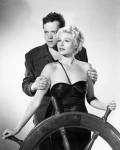 genre and the period of Hollywood film making.
genre and the period of Hollywood film making.
>>More to see: Looking for more out of life?
>>Real Life Story: Katie and Nathan realized that they were driving each other into someone else’s arms. See the real life turnaround in their marriage.
Orson Welles as Michael O’Hara gives us his rendition of the poetic Irish soul in this famous “shark scene on video clip. See below a re-cut, remixed video trailer for “The Lady From Shanghai” (1947)
The Bicycle Thief (1948)
 “The Bicycle Thief” (1948), is a small masterpiece on celluloid that captures the human drama of a family man struggling to maintain his livelihood and his dignity by recovering a stolen bicycle in post-war Rome. This Italian language film by Vittorio de Sica maintained my interest even with the English subtitles. Taking in a film through translation may be akin to listening to a symphony orchestra through a tin can telephone. One is sure to miss something in the translation. However, the acting on the part of the father and son duo (played
“The Bicycle Thief” (1948), is a small masterpiece on celluloid that captures the human drama of a family man struggling to maintain his livelihood and his dignity by recovering a stolen bicycle in post-war Rome. This Italian language film by Vittorio de Sica maintained my interest even with the English subtitles. Taking in a film through translation may be akin to listening to a symphony orchestra through a tin can telephone. One is sure to miss something in the translation. However, the acting on the part of the father and son duo (played 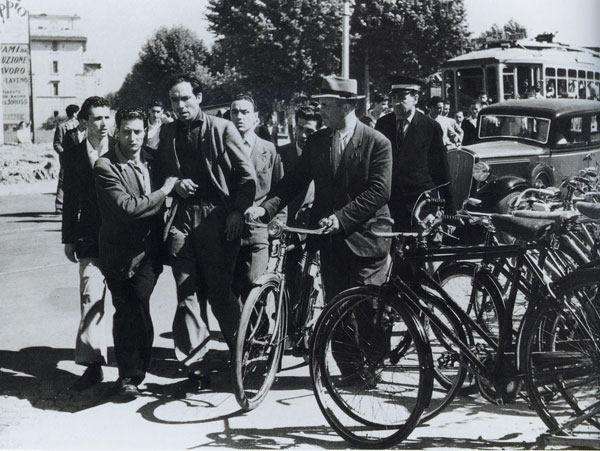 by Lamberto Maggiorani and Enzo Staiolo respectively) is so convincing both through dialogue and the non-verbal, that one can forgive the ongoing necessity of the subtitles. Following the everyman character about the streets of Rome in his desperate search for his bicycle gives us the full range of an emotional workout and a depth of sociological analysis that the “official bus tour” of the famous Eternal City would never afford.
by Lamberto Maggiorani and Enzo Staiolo respectively) is so convincing both through dialogue and the non-verbal, that one can forgive the ongoing necessity of the subtitles. Following the everyman character about the streets of Rome in his desperate search for his bicycle gives us the full range of an emotional workout and a depth of sociological analysis that the “official bus tour” of the famous Eternal City would never afford.
>>More to see: Looking for more out of life?
See a trailer for "The Bicycle Thief" (1948)





